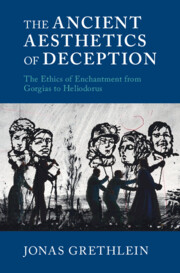Book contents
- The Ancient Aesthetics of Deception
- The Ancient Aesthetics of Deception
- Copyright page
- Contents
- List of Figures
- Acknowledgements
- Chapter 1 Gorgias and the Justice of Tragic Apatē
- Chapter 2 The Circulation and Significance of Apatē in the Classical Era
- Chapter 3 The Dramatic Entanglement of Aesthetic Illusion with Deceit in Sophocles’ Electra
- Chapter 4 Immersion and Corruption in Plato’s Republic
- Chapter 5 The Void of Hellenistic Criticism
- Chapter 6 The Appeal and Challenge of Apatē in Imperial Criticism: Plutarch’s De audiendis poetis
- Chapter 7 Lucian and the Spell of Philosophy
- Chapter 8 How to Read Ekphrasis: The Tabula Cebetis
- Chapter 9 Christian Polemics against Idolatry: Clement of Alexandria’s Protrepticus
- Chapter 10 The Aesthetics of Deception Reconfigured in Heliodorus’ Ethiopica
- Chapter 11 From Deepfake to Psychotherapy: The Aesthetics of Deception Today
- Bibliography
- Index Locorum
- General Index
Chapter 7 - Lucian and the Spell of Philosophy
Published online by Cambridge University Press: 23 August 2021
- The Ancient Aesthetics of Deception
- The Ancient Aesthetics of Deception
- Copyright page
- Contents
- List of Figures
- Acknowledgements
- Chapter 1 Gorgias and the Justice of Tragic Apatē
- Chapter 2 The Circulation and Significance of Apatē in the Classical Era
- Chapter 3 The Dramatic Entanglement of Aesthetic Illusion with Deceit in Sophocles’ Electra
- Chapter 4 Immersion and Corruption in Plato’s Republic
- Chapter 5 The Void of Hellenistic Criticism
- Chapter 6 The Appeal and Challenge of Apatē in Imperial Criticism: Plutarch’s De audiendis poetis
- Chapter 7 Lucian and the Spell of Philosophy
- Chapter 8 How to Read Ekphrasis: The Tabula Cebetis
- Chapter 9 Christian Polemics against Idolatry: Clement of Alexandria’s Protrepticus
- Chapter 10 The Aesthetics of Deception Reconfigured in Heliodorus’ Ethiopica
- Chapter 11 From Deepfake to Psychotherapy: The Aesthetics of Deception Today
- Bibliography
- Index Locorum
- General Index
Summary
Chapter 7 moves on to Lucian, who extends the field of reflection by conjuring up the entwinement of deception with aesthetic illusion, not exclusively but chiefly in texts devoted to philosophy and its pretensions. Philopseudes uses the allure of superstitious tales circulated by philosophers to contemplate the effect of immersive narrative at large; Nigrinus calls upon the aesthetics of deception to expose the shortcomings of protreptic discourse and facile ideas of conversion; Hermotimus compares philosophical misguidance to the effects of visual art and poetry. However, Lucian’s engagement with the aesthetics of deception is not confined to ridiculing philosophy; it is carried by a serious concern with the effects of logos as diagnosed by Plato. The high reflexivity that the form of dialogue and the layering of narrative levels generate in the discussed texts can be seen as a response to the danger inherent in immersion.
Keywords
- Type
- Chapter
- Information
- The Ancient Aesthetics of DeceptionThe Ethics of Enchantment from Gorgias to Heliodorus, pp. 166 - 198Publisher: Cambridge University PressPrint publication year: 2021

